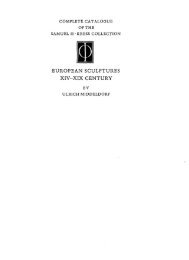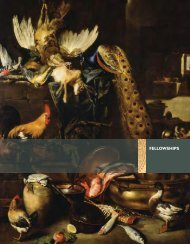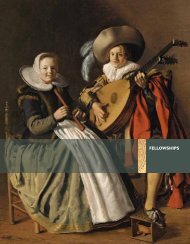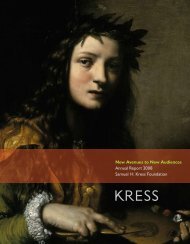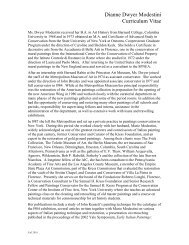The Campus Art Museum - Samuel H. Kress Foundation
The Campus Art Museum - Samuel H. Kress Foundation
The Campus Art Museum - Samuel H. Kress Foundation
Create successful ePaper yourself
Turn your PDF publications into a flip-book with our unique Google optimized e-Paper software.
Some describe their campus art museum as gem-like in beauty and value.<br />
Perhaps because a huge gem show was in Tucson when I visited, the gem metaphor<br />
was particularly popular in describing the University of Arizona <strong>Museum</strong> of <strong>Art</strong><br />
(UAMA). Interestingly, as often as the UAMA is described as a gem, it is also<br />
referred to as a hidden gem:<br />
We are sort of a hidden treasure…. (UAMA staff)<br />
…someone dressed in a beautiful, stunning ball gown…, but sequestered, not as<br />
well seen as she should be…. She’s not out in the front room of the party…. She’s<br />
the little gem in the back room. (arts professor)<br />
<strong>The</strong> museum as gem attracts, it is special, beautiful, and valuable. It is a<br />
recipient of the gaze. Others emphasize the narrative aspects of their museum.<br />
More active than a collection of objects to be admired, the art museum can also<br />
tell stories and be the site for the production of multiple narratives, as noted by a<br />
curator: “Increasingly, we are finding opportunities to bring people together around<br />
art to talk about any number of things, whether it’s climate change or gender issues,<br />
or what have you.”<br />
<strong>Campus</strong> administrators, in particular, describe the art museum as a research<br />
or teaching laboratory, comparable to those in science. As a research laboratory,<br />
art history students might study specific works of art or education students<br />
might observe a grade school tour and how children talk about art. As a teaching<br />
laboratory, faculty across disciplines explore ways to expand the scope of their<br />
courses and teaching methods through use of the art museum, as described by an<br />
administrator at Oberlin College:<br />
We see the museum as a teaching tool, as a pedagogical tool. It’s just an<br />
incredible resource for us to have…. What I think is effective at Oberlin in<br />
particular is that the art museum isn’t considered the domain of the art<br />
department…. But there are classes everywhere across campus that use the<br />
museum from economics to biology and neuroscience…. What I think is<br />
impressive about Oberlin is that clearly the academic program as a whole<br />
owns the museum.<br />
Another common metaphor is the campus art museum as library. A library’s<br />
resources are used for knowledge generation, research, and pleasure; the same is<br />
possible with a museum’s collections. Just as a good library is responsive to the<br />
needs of students and faculty, so too is the good campus art museum, as noted by<br />
an administrator at the University of Kansas (KU): “I know I could call down here<br />
and the art museum would go out of its way to help a student.”<br />
Staff at several museums in the study focus attention on interactions with<br />
both campus and wider communities. This effort is reflected in how interviewees<br />
talk about their museum as a kind of portal or gateway that extends the museum<br />
beyond its walls and also draws people within. Although I heard this metaphor<br />
elsewhere as well, it was at KU where the Spencer <strong>Museum</strong> of <strong>Art</strong> (Spencer) puts<br />
considerable effort into extending the museum beyond the walls of the building,<br />
Metaphor and Meaning of the <strong>Campus</strong> <strong>Art</strong> <strong>Museum</strong><br />
6



